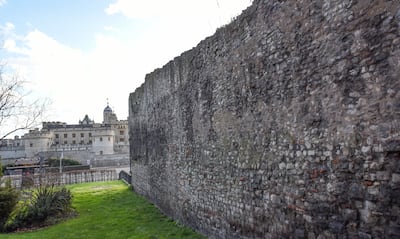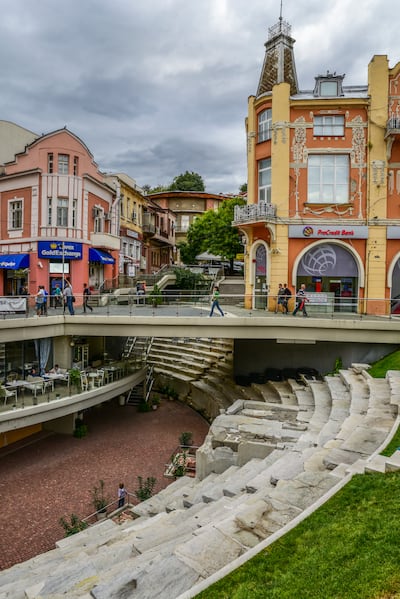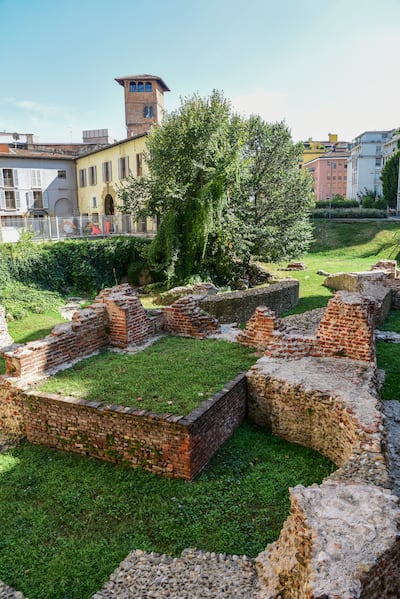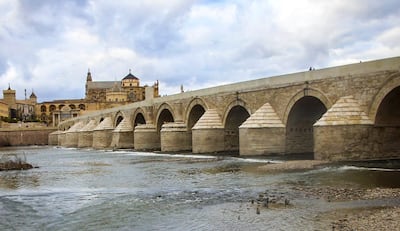From a Roman city lurking beneath London, to a grand square in Athens, a stunning bridge in southern Spain, an uncovered city in Bulgaria and an overlooked palace in Milan, Europe is brimming with ancient Roman sites.
Here are five of the continent’s most interesting remains.
London, UK
Each and every day, Londoners literally walk all over remnants of the Roman Empire. Concealed beneath the streets of this city’s busy financial district are Roman forts, barracks, amphitheatres, mansions and temples. Some are inaccessible, while others have been excavated and can be explored by tourists keen to learn how the Romans created London almost 2,000 years ago.
Not long after the Romans invaded Britain in the 1st century AD, they constructed a new riverside community, named Londinium. Sitting below street level, opposite the Museum of London, is a cluster of crumbling walls that were once part of the hub of Londinium. This was the mighty Roman Fort, a five-hectare complex that at times was home to up to 1,000 Roman soldiers.
For entertainment, those men walked to a nearby site that was only rediscovered by accident in 1988 – the Roman Amphitheatre. I had to descend six metres below the Guildhall Art Gallery to see the ruins of that grand ancient venue, which now functions as a museum.
Soon after, I was again beneath London chasing Roman ghosts. Not soldiers or noblemen, but members of the Roman Cult of Mithras. Those shadowy men hid their ritualistic activities in an underground temple that was excavated in the 1950s, then carefully restored and opened to the public four years ago. The Roman Empire’s DNA is all over London. Just look down.
Plovdiv, Bulgaria
Few people outside of Bulgaria will have heard of Plovdiv. But in 2019, this small, attractive city earned greater worldwide exposure due to its year-long stint as the European Capital of Culture, a title that put a spotlight on its little-known yet remarkable Roman sites.
I took my mother to Plovdiv to admire the ostentatious, 19th-century Baroque architecture of its old town. Only a few hundred metres away from that unique neighbourhood, we made an unexpected find. Despite dating back almost 2,000 years, the Ancient Stadium of Philippopolis and the Ancient Theatre of Philippopolis are in terrific condition.
With its enormous terraced seating, the latter venue held musical and theatre performances for crowds of up to 3,000 people. Yet it was tiny compared to the nearby stadium. Philippopolis could accommodate seven times that many spectators, who cheered and jeered the competitors in Roman sports. Now tourists can freely wander through both of these ancient venues while imagining the spectacles that once occurred there.
Milan, Italy
Italy is so heavily endowed with historical treasures that it’s no surprise many go unnoticed. When I read a small sign in a nondescript alley in Milan, I couldn’t believe what it said. The site in front of me was once the palace of a Roman Emperor.
In many cities around the world, such a significant location would be a widely publicised tourist attraction. In Milan, though, this former palace is chiefly used as a shortcut route for locals looking to access the busy Via Meravigli street.
The cluster of walls here are remains of the Imperial Palace of Maximian. A highly-decorated Roman soldier, Maximian ascended to Emperor status more than 1,700 years ago. In the 1950s, excavations of this part of downtown Milan revealed the giant complex he built for himself. Now, if you’re so inclined, you can head into Milan’s backstreets and wander the halls, courts and bathhouses where Maximian once resided.
Athens, Greece
Unlike most of the Roman sites in this story, the Roman Forum of Athens isn’t tucked away. Instead, it is situated in the shadows of the Acropolis, the hilltop citadel that is Greece’s most famous attraction, in plain view of hordes of tourists.
Amid the endless Greek ruins of downtown Athens, this forum isn’t easily identified as being Roman. At least, it wasn’t to me. Not until I read a plaque in front of this field of time-worn columns, arches and walls did I realise it was built 2,000 years ago at the behest of renowned Roman Emperor Julius Caesar.
Prior to that, I’d been assessing this trove of weathered buildings from one of the cafes that flank the Roman Forum in Plaka. Also known as an Agora, this forum became one of Athens’s largest public squares after Greece was absorbed into the Roman empire in the 1st century BC. While walking through these remains is a fascinating experience, the best views of the sprawling Agora are earned as you walk up the hill towards the Acropolis.
Cordoba, Spain
The southern Spanish city of Cordoba has a wonderfully diverse range of influences. It is unmistakably Spanish in culture, yet bears the marks of Roman, Germanic and Arabic occupations. This blended heritage is highlighted in Cordoba’s Unesco-listed Old Town by the unique Mezquita, a magnificent, 1,200-year-old building that operates as both a mosque and a Catholic cathedral.
Residents from the southern half of Cordoba can access the Old Town by crossing the Guadalquivir River. They couldn’t do that so freely if not for the city’s commanding Roman Bridge. The slow-moving river flows through the 16 giant arches at the base of this 300-metre-long stone bridge, which has a low-slung design with a tower at each end.
Since it was built 2,000 years ago, this bridge has been remodelled repeatedly. But it still maintains many original elements designed by the Romans. In the 3rd century AD, they seized Cordoba and controlled it for more than 600 years. Nowadays, the splendid footbridge they left behind is the best vantage from which to take panoramic photos of Cordoba’s eclectic Old Town.
What vitamins do we know are beneficial for living in the UAE
Vitamin D: Highly relevant in the UAE due to limited sun exposure; supports bone health, immunity and mood.
Vitamin B12: Important for nerve health and energy production, especially for vegetarians, vegans and individuals with absorption issues.
Iron: Useful only when deficiency or anaemia is confirmed; helps reduce fatigue and support immunity.
Omega-3 (EPA/DHA): Supports heart health and reduces inflammation, especially for those who consume little fish.
TOP 5 DRIVERS 2019
1 Lewis Hamilton, Mercedes, 10 wins 387 points
2 Valtteri Bottas, Mercedes, 4 wins, 314 points
3 Max Verstappen, Red Bull, 3 wins, 260 points
4 Charles Leclerc, Ferrari, 2 wins, 249 points
5 Sebastian Vettel, Ferrari, 1 win, 230 points
What's in the deal?
Agreement aims to boost trade by £25.5bn a year in the long run, compared with a total of £42.6bn in 2024
India will slash levies on medical devices, machinery, cosmetics, soft drinks and lamb.
India will also cut automotive tariffs to 10% under a quota from over 100% currently.
Indian employees in the UK will receive three years exemption from social security payments
India expects 99% of exports to benefit from zero duty, raising opportunities for textiles, marine products, footwear and jewellery
The specs: 2018 Mitsubishi Eclipse Cross
Price, base / as tested: Dh101,140 / Dh113,800
Engine: Turbocharged 1.5-litre four-cylinder
Power: 148hp @ 5,500rpm
Torque: 250Nm @ 2,000rpm
Transmission: Eight-speed CVT
Fuel consumption, combined: 7.0L / 100km
More Iraq election coverage:
BMW M5 specs
Engine: 4.4-litre twin-turbo V-8 petrol enging with additional electric motor
Power: 727hp
Torque: 1,000Nm
Transmission: 8-speed auto
Fuel consumption: 10.6L/100km
On sale: Now
Price: From Dh650,000
F1 The Movie
Starring: Brad Pitt, Damson Idris, Kerry Condon, Javier Bardem
Director: Joseph Kosinski
Rating: 4/5
The specs: Lamborghini Aventador SVJ
Price, base: Dh1,731,672
Engine: 6.5-litre V12
Gearbox: Seven-speed automatic
Power: 770hp @ 8,500rpm
Torque: 720Nm @ 6,750rpm
Fuel economy: 19.6L / 100km
Dubai works towards better air quality by 2021
Dubai is on a mission to record good air quality for 90 per cent of the year – up from 86 per cent annually today – by 2021.
The municipality plans to have seven mobile air-monitoring stations by 2020 to capture more accurate data in hourly and daily trends of pollution.
These will be on the Palm Jumeirah, Al Qusais, Muhaisnah, Rashidiyah, Al Wasl, Al Quoz and Dubai Investment Park.
“It will allow real-time responding for emergency cases,” said Khaldoon Al Daraji, first environment safety officer at the municipality.
“We’re in a good position except for the cases that are out of our hands, such as sandstorms.
“Sandstorms are our main concern because the UAE is just a receiver.
“The hotspots are Iran, Saudi Arabia and southern Iraq, but we’re working hard with the region to reduce the cycle of sandstorm generation.”
Mr Al Daraji said monitoring as it stood covered 47 per cent of Dubai.
There are 12 fixed stations in the emirate, but Dubai also receives information from monitors belonging to other entities.
“There are 25 stations in total,” Mr Al Daraji said.
“We added new technology and equipment used for the first time for the detection of heavy metals.
“A hundred parameters can be detected but we want to expand it to make sure that the data captured can allow a baseline study in some areas to ensure they are well positioned.”
BACK%20TO%20ALEXANDRIA
%3Cp%3E%3Cstrong%3EDirector%3A%20%3C%2Fstrong%3ETamer%20Ruggli%3C%2Fp%3E%0A%3Cp%3E%3Cstrong%3EStarring%3A%20%3C%2Fstrong%3ENadine%20Labaki%2C%20Fanny%20Ardant%3C%2Fp%3E%0A%3Cp%3E%3Cstrong%3ERating%3A%20%3C%2Fstrong%3E3.5%2F5%3C%2Fp%3E%0A
Who's who in Yemen conflict
Houthis: Iran-backed rebels who occupy Sanaa and run unrecognised government
Yemeni government: Exiled government in Aden led by eight-member Presidential Leadership Council
Southern Transitional Council: Faction in Yemeni government that seeks autonomy for the south
Habrish 'rebels': Tribal-backed forces feuding with STC over control of oil in government territory
UAE rugby season
FIXTURES
West Asia Premiership
Dubai Hurricanes v Dubai Knights Eagles
Dubai Tigers v Bahrain
Jebel Ali Dragons v Abu Dhabi Harlequins
UAE Division 1
Dubai Sharks v Dubai Hurricanes II
Al Ain Amblers v Dubai Knights Eagles II
Dubai Tigers II v Abu Dhabi Saracens
Jebel Ali Dragons II v Abu Dhabi Harlequins II
Sharjah Wanderers v Dubai Exiles II
LAST SEASON
West Asia Premiership
Winners – Bahrain
Runners-up – Dubai Exiles
UAE Premiership
Winners – Abu Dhabi Harlequins
Runners-up – Jebel Ali Dragons
Dubai Rugby Sevens
Winners – Dubai Hurricanes
Runners-up – Abu Dhabi Harlequins
UAE Conference
Winners – Dubai Tigers
Runners-up – Al Ain Amblers
England's all-time record goalscorers:
Wayne Rooney 53
Bobby Charlton 49
Gary Lineker 48
Jimmy Greaves 44
Michael Owen 40
Tom Finney 30
Nat Lofthouse 30
Alan Shearer 30
Viv Woodward 29
Frank Lampard 29
Juliot Vinolia’s checklist for adopting alternate-day fasting
- Don’t do it more than once in three days
- Don’t go under 700 calories on fasting days
- Ensure there is sufficient water intake, as the body can go in dehydration mode
- Ensure there is enough roughage (fibre) in the food on fasting days as well
- Do not binge on processed or fatty foods on non-fasting days
- Complement fasting with plant-based foods, fruits, vegetables, seafood. Cut out processed meats and processed carbohydrates
- Manage your sleep
- People with existing gastric or mental health issues should avoid fasting
- Do not fast for prolonged periods without supervision by a qualified expert
Dhadak
Director: Shashank Khaitan
Starring: Janhvi Kapoor, Ishaan Khattar, Ashutosh Rana
Stars: 3
The specs
Engine: 2.0-litre 4cyl turbo
Power: 261hp at 5,500rpm
Torque: 405Nm at 1,750-3,500rpm
Transmission: 9-speed auto
Fuel consumption: 6.9L/100km
On sale: Now
Price: From Dh117,059
2025 Fifa Club World Cup groups
Group A: Palmeiras, Porto, Al Ahly, Inter Miami.
Group B: Paris Saint-Germain, Atletico Madrid, Botafogo, Seattle.
Group C: Bayern Munich, Auckland City, Boca Juniors, Benfica.
Group D: Flamengo, ES Tunis, Chelsea, (Leon banned).
Group E: River Plate, Urawa, Monterrey, Inter Milan.
Group F: Fluminense, Borussia Dortmund, Ulsan, Mamelodi Sundowns.
Group G: Manchester City, Wydad, Al Ain, Juventus.
Group H: Real Madrid, Al Hilal, Pachuca, Salzburg.
MATCH INFO
Quarter-finals
Saturday (all times UAE)
England v Australia, 11.15am
New Zealand v Ireland, 2.15pm
Sunday
Wales v France, 11.15am
Japan v South Africa, 2.15pm
How to protect yourself when air quality drops
Install an air filter in your home.
Close your windows and turn on the AC.
Shower or bath after being outside.
Wear a face mask.
Stay indoors when conditions are particularly poor.
If driving, turn your engine off when stationary.
Total eligible population
About 57.5 million people
51.1 million received a jab
6.4 million have not
Where are the unvaccinated?
England 11%
Scotland 9%
Wales 10%
Northern Ireland 14%
Racecard
6.35pm: American Business Council – Maiden (PA) Dh80,000 (Dirt) 1,600m
7.10pm: British Business Group – Maiden (TB) Dh82,500 (D) 1,200m
7.45pm: CCI France UAE – Handicap (TB) Dh87,500 (D) 1,400m
8.20pm: Czech Business Council – Rated Conditions (TB) Dh105,000 (D) 1,400m
8.55pm: Netherlands Business Council – Rated Conditions (TB) Dh95,000 (D) 1,600m
9.30pm: Indian Business and Professional Council – Handicap (TB) Dh95,000 (D) 1,200m
UAE currency: the story behind the money in your pockets






